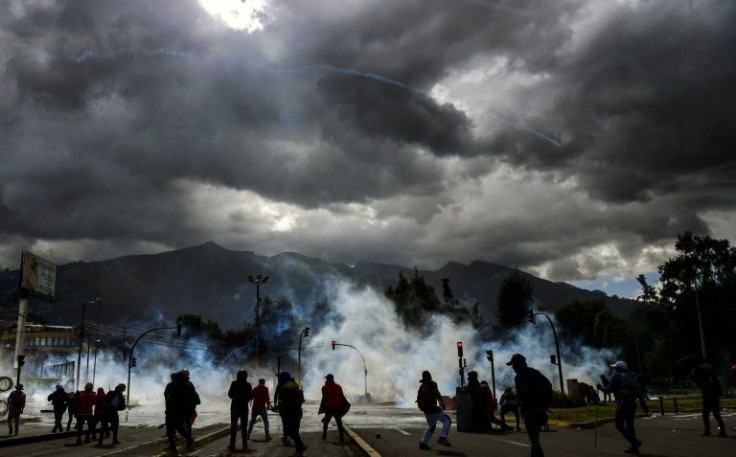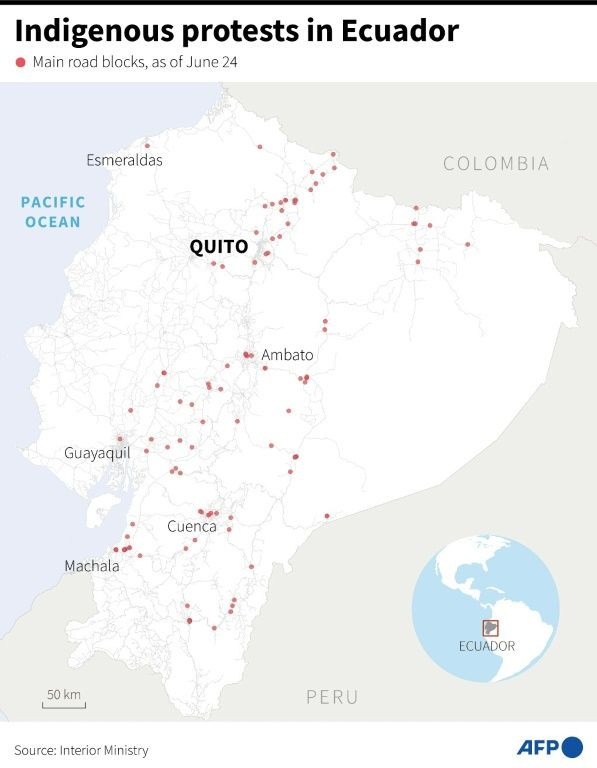Ecuador's Leader Warns Of Coup Over Indigenous Protests
Violent clashes between Indigenous protesters and police broke out for a second straight day in Ecuador's capital on Friday, as the country's president accused demonstrators of attempting a coup.
Nearly two weeks into protests that have left six people dead and dozens injured, thousands of demonstrators angry at rising fuel prices threw rocks and Molotov cocktails and shot off fireworks near the congress building in Quito.
Security forces repelled protesters with tear gas, and clashes eventually stopped late in the evening, according to AFP reporters on the scene.

"The real intention of these violent people is to stage a coup," President Guillermo Lasso said in a speech earlier Friday in which he again offered dialogue to end the protests.
An estimated 14,000 protesters are taking part in a nationwide show of discontent against rising hardship in an economy dealt a serious blow by the coronavirus pandemic.
Most of the ire is concentrated in the capital Quito, where some 10,000 people, most from other parts of the country, have gathered.

Both sides accused each other of intransigence on Friday, as the protests entered their 12th day.
"They have unmasked themselves. They don't want to negotiate. They don't want to come to an agreement... They don't want peace. Until now, the only thing they have demonstrated is that they want violence," minister of government Francisco Jimenez told broadcaster FM Mundo.
Six of the country's 24 provinces are under a state of emergency and a night-time curfew is in place in Quito.

Protesters are demanding a cut in already subsidized fuel prices, which have risen sharply in recent months, as well as jobs, food price controls, and more public spending on healthcare and education.

But the action has been costly, with losses of some $50 million per day to the economy, and production of fuel -- Ecuador's biggest export -- halved, according to the energy ministry.
On Thursday, protesters won a limited concession from President Guillermo Lasso who granted them access, "for the sake of dialogue and peace," to a cultural center emblematic of the Indigenous struggle that had been commandeered by police.
Hours later, however, a group of protesters headed for Congress, where police fired tear gas in response to a barrage of rocks, fireworks and Molotov cocktails.
Three people died in confrontations on Thursday, bringing the toll to six since the movement started on June 13 on the initiative of the powerful Confederation of Indigenous Nationalities of Ecuador (Conaie).
Conaie leader Leonidas Iza told AFP the revolt would continue "until we have results. We can no longer hold back the anger of the people."
People were desperate, said Iza.
"We expected the president to answer the central questions of the crisis, the poverty our people are experiencing. The economic question is one of despair, which is why we are here," he said.
"There is a lot of poverty, the increase in the price of fuel has increased all the prices, and we, the poorest, are the ones who suffer the most."
Conaie is credited with bringing down three presidents between 1997 and 2005.
Its most recent mobilization has brought Quito to a standstill, and many shop owners and workers in the capital do not look kindly on what they see as an invasion, flying white anti-protest flags.
"The class struggle has deepened," said Iza in response.
No talks have been scheduled between the government and Conaie.
© Copyright AFP 2024. All rights reserved.





















